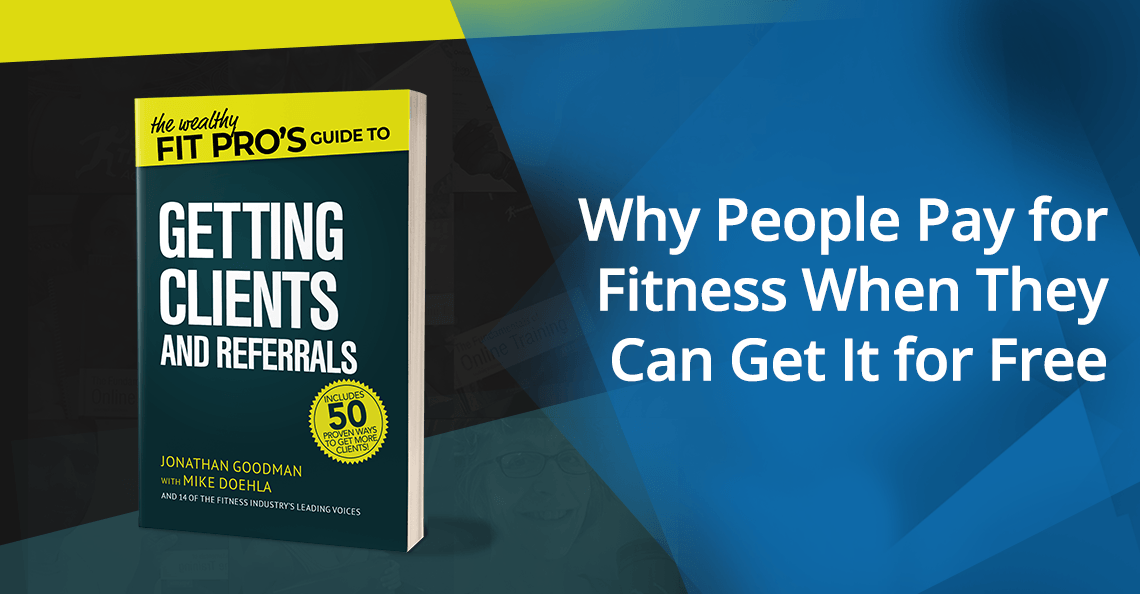The following excerpt is from The Wealthy Fit Pro’s Guide to Getting Clients and Referrals.
Fitness has always been free.
It costs nothing to run, jump, and play. Just about anybody can get in shape using free outdoor or community facilities.
Anybody with internet access can find hundreds of free workout programs. Same with nutrition guides and recipes.
So why is the global health and fitness industry worth more than a trillion dollars? And why are so many consumers willing to pay a premium for something they don’t actually need to pay for?
An even better question: How can you add enough value to your service so people beg to buy something from you—something they know they can get for free with a couple of clicks?
To find the answers, let’s start with the most important person in the world: you.
A client walks into a gym …
Odds are, by the time a client contacts you, they’ve already read articles, watched videos, followed fitness experts on Instagram or Facebook, and maybe even bought a book or two.
They’ll have preconceptions about the right approach to fitness. You may agree. You may not.
The point is, if you wait until they walk into your gym to impress upon them the superiority of your wonderful/special/unprecedented approach, you’re four to six months too late. They already believe something, and it’s going to be hard to change their mind.
The barriers to entering the fitness market are so low they’re barely speed bumps. Anybody can develop a (free) website, upload some (cell phone) photos, give their (un)educated opinion, and broadcast their (self-proclaimed) expertise on social media. Sometimes the information is good. Other times ... not so much.
The fitness industry has become both democratized and decentralized.
Power is no longer in the hands of a few big players.
Anyone can broadcast anything to anyone who’ll pay attention.
The effects of this market disruption have fundamentally shifted how you must approach the business.
Back when fitness was mostly a local thing, proximity was your most powerful marketing tool. As long as you were close to a prospect, you had a chance of selling them on your way of training and converting them into a client.
That was then. No one today has a monopoly on attention or credibility. Not in an era of infinite shelf space.
None of this is unique to the fitness industry, of course. Picture a bookstore. Even the biggest stores, for all their shelves and tables and storage rooms, have finite space. They can give you a few choices on any topic you’re interested in, but they can’t give you every choice.
Amazon changed that. With no physical limitations to its inventory, Amazon gives you access to almost any book that’s ever been published on just about any topic. And if it’s been published in the past decade or two, you can probably get the ebook version delivered instantly.
The same applies to fitness.
Your competition isn’t the other trainers in your gym, or the other gyms in your neighborhood.
It’s everybody with a website, podcast, Facebook group, or Instagram following.
Feel overwhelmed or intimidated? Don’t. Two things happen in any decentralized, democratized market, both of which are very good news for you:
- The cream rises to the top. When power shifts back to consumers, quality beats quantity, even if it takes some time.
- Lots of people win, even if only a few win big. Without gatekeepers, a few players will build huge businesses. But at the same time, smaller businesses that otherwise wouldn’t have had much opportunity will thrive.
There’s more opportunity for you now than ever before. But to take advantage, you have to be willing to do something most people don’t.
No, I’m not talking about having the biggest ego or the loudest mouth. What you need to do is solve the central mystery of why people spend money. To do that, you have to open your mind to the power of you.
Where you fit in the evolving fitness marketplace
Like I said, the cost of entry to the market is close to zero.
Personal training certifications are cheap and easy, and online trainers don’t even need one. Most trainers operate without insurance. (Don’t be one of those trainers. You need insurance.) You can produce free content with the phone in your pocket and reach anybody in the world through social media.
That’s why the first stage in a decentralized market is a widening wealth gap. A few win big, and many become frustrated. The people who figure out how to trick the tools (and get lucky) take home the vast majority of the riches.
We’ve been in this first stage for a while. It’s discouraged a lot of good fitness pros.
But the pendulum swings both directions. When decentralization starts, it knocks the pendulum off kilter, and everything gets nutty. Over time, the market regulates itself and things settle.
We’re just now entering the more stable stage. Nutty stuff will still happen. This is the fitness industry, after all, and nutty stuff always happens. But once we’re firmly in the second stage, we’ll stay there for many years because it’s so much more sustainable than the current ecosystem.
What are the hallmarks of this new stage?
- Power flows back to the consumer. Reputational damage takes out low-quality producers because public review communities become more powerful and accessible. That gives unhappy clients a forum to share details about lousy service and results, warning potential clients away.
- The cost to enter the market increases. Rising ad costs, fractured customer attention, and the rapid decline of organic reach mean large, previously influential companies and individuals can no longer capture and monopolize audiences.
- Smaller service providers see unprecedented opportunity. It’s impossible to target the entire audience in a decentralized market, which opens things up to smaller providers who play at the fringes. That means you, and that’s very exciting.
Get More Personal Training Clients and Referrals!

Are you a personal trainer who’s struggling to fill your schedule with paying clients? Confused about how to market yourself without spending a lot of money?
The Wealthy Fit Pro’s Guide to Getting Clients and Referrals has the answers. Let Jonathan Goodman show you:
- Why people pay for fitness when they can get it for free (p. 1)
- How to get more people to buy from you (p. 28)
- How to succeed in fitness marketing without really trying (p. 59)
- 3 fitness marketing principles you must follow (ignore them at your peril) (p. 77)
- 7 components of compelling offers that leave clients begging to buy (p. 89)
- Savvy long-term client conversion strategies (p. 99)
- Fast one-off promotions for new clients (p. 137)
- Multimillion-dollar guerrilla marketing secrets revealed! (p. 181)
- Guaranteed systems, strategies, and scripts for generating referrals (p. 207)
- Includes: 50 proven ways to get more clients
Order this book in paperback today and get the audio and digital versions 100% FREE (a $40 value).
It all starts by clicking here: The Wealthy Fit Pro’s Guide to Getting Clients and Referrals










